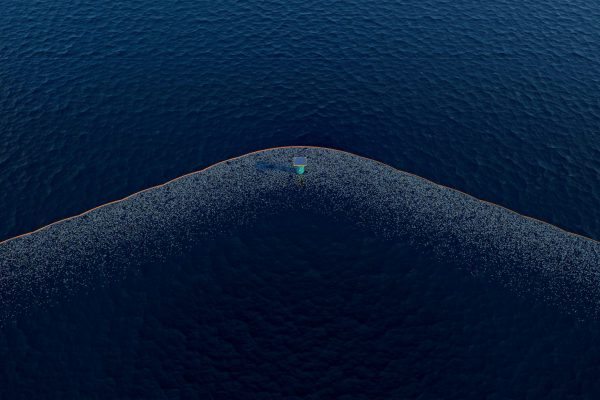Trash transported from poorly managed terrestrial landfills and from rivers, trash liberated by tsunamis and garbage tossed out at sea; fishing nets, buoys and spilled cargo containers are filling the oceans at an alarming rate. Huge areas of many of the oceans on planet earth have become trash soup. The main ingredient of the trash soup is plastic and chemical sludge. Plastics do not biodegrade, at best they photodegrade, breaking down in the sun and surf into minute pieces. It is estimated that a plastic water bottle will take 450 years and a Styrofoam cup will take 50 years to disappear.
Organic toxins such as PCBs, PBDEs, and PAHs can adhere to plastics and bio accumulate (concentrate as they move up the food chain). A source of plastic pollution that you probably never thought of is microbeads – the tiny colorful, plastic beads found in face and body scrubs and toothpaste. Microbeads are composed of a variety of plastics that absorb persistent organic pollutants and other industrial chemicals. Microbeads look like fish eggs and are ingested by fish and the toxins move up the food chain. Sea turtles, especially leatherbacks, eat plastic bags mistaking them for jellyfish. Researchers have found an alarming amount of plastic in the guts of many seabirds and birds like albatross are especially vulnerable because they skim the surface for food. Necropsies of birds have found plastic bags, fishing line, bits of plastic, and fibers from clothing and nylon rope.

Ocean currents flow in complex patterns affected by wind, water density, salinity, solar heating of the waters near the equator, topography of the ocean floor and the rotation of the earth. These currents create large scale eddies called gyres. There are five major gyres: North Pacific, South Pacific, North Atlantic, South Atlantic and Indian Ocean. The gyres concentrate the trash creating trash soup. I have read that the trash has concentrated into huge mats or islands, but this is not the case. The tiny bits of plastic make a soup peppered with plastic bits and oil sludge. The gyres are impossible to map because, in places the plastic soup is nearly invisible. Scientists believe the density of plastics in some gyres is up to 580,000 pieces per km2.

Everyone who studies ocean landfills and trash soup agrees that it is a problem of huge and global importance, but the solution is far from clear. The issues that make a solution very difficult are the size of the problem – huge, and the size of the particles – tiny. A typical sample of ocean plastic includes a large amount of microscopic plankton and other organisms that are important to the ocean ecosystem, so just removing the bits of plastic would remove a considerable amount of plankton.
Hopeful Solutions
There are several proposed techniques for trash removal. The Ocean Cleanup Project proposes to erect a large angled barrier attached to the ocean floor in the areas of densest garbage accumulation. Ocean currents would passively push the plastic into a collection zone. The Seabin Project deploys a mobile open bucket with a filter that collects trash and the filter can be removed and the debris emptied. This technique would be best for local cleanup. The Bay Debris Sweeper looks like a barge with wings that capture ocean debris. Clearly there are many details to work out with all of these ideas. What will be done with all of the plastic bits?

How Can I Make A Difference?
Even if we stopped discarding plastic today we still have millions of hectares of plastic in the sea. Clearly, this is a global problem, but we all need to do what we can to be part of the solution. First and foremost use less plastic and when you do use plastic keep it out of the sea. Use refillable water containers, bring re-useable tote bags to market and find more sustainable solutions to every day plastic refuse. Stop using products with microbeads. Recycle plastic when you can, but remember that it is not a real solution. Recycling plastic is an overall energy drain. The plastics are sorted, chopped into small pieces, cleaned, melted and compressed into nurdles. The nurdles are turned into plastic products, but never into the original products such as water bottles. Recycled plastic bags with added sawdust are used for plastic lumber, but this process is expensive and energy intensive. Reuse, Recycle and Refuse plastic.
REFERENCES:
http://www.theoceancleanup.com
http://www.seabinproject.com
http://www.gyrecleanup.org/cleanup-plan/
https://www.allatsea.net/gyres-big-trash-eddies-and-rubber-ducks/





